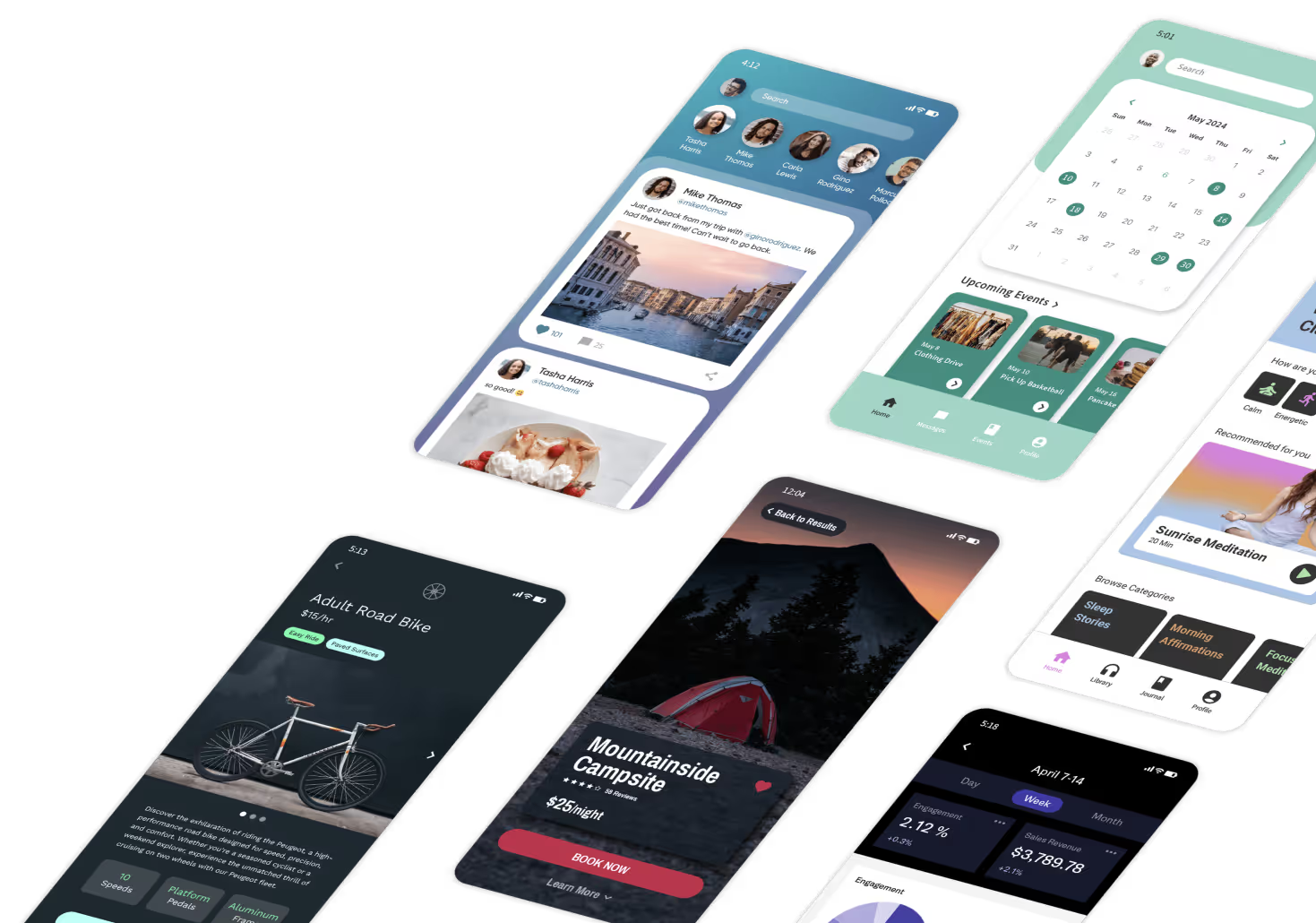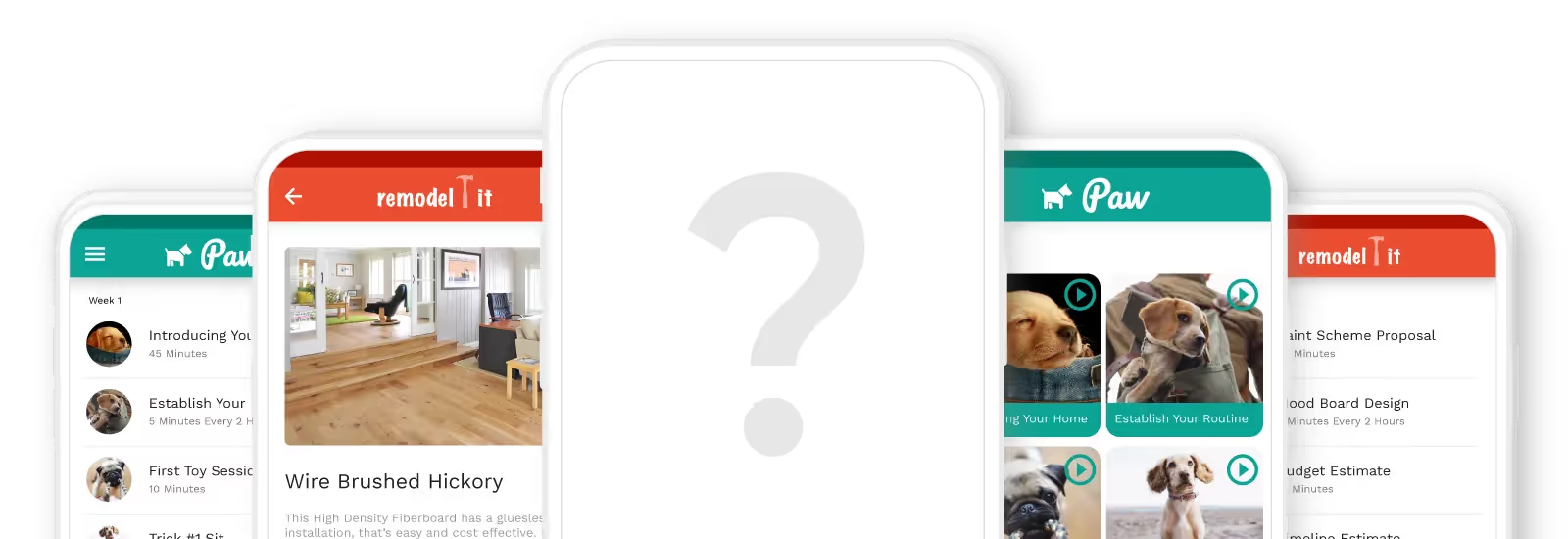
Wondering how to turn your app idea into a reality? Nailing your investor pitch is a crucial first step to securing the funding you need. We’ll walk you through each stage of the process, including how to develop a standout pitch deck.
Read on to learn more about:
- Determining what investors want, networking, and developing your pitch
- How to create a compelling app pitch deck
- Where and how to pitch your app idea
- Tips for presenting your pitch to investors
Now, let’s examine some steps you need to take before pitching an app idea.
Getting Started: Understand What Investors Want

Before getting in touch with investors, it helps to understand their expectations, capacity, and needs. Notably, some investors only invest in app stages in the product development cycle — here are the general investment stages:
- Pre-Seed: This is the earliest stage of funding, during which you refine your app ideas, build prototypes, and validate market demand. Money often comes from your funds, family, friends, or even a GoFundMe page. Your main focus is on developing a viable app and gaining initial traction.
- Seed: Seed funding is typically used for product development, market research, and building a customer base, taking your app idea from concept to the first stages of operation. Investors often include angel investors, early-stage venture capitalists, and incubators.
- Series A: By the time you reach Series A, you’ll need a startup app or minimum viable product (MVP) and a proven business model with revenue streams. This funding round typically focuses on scaling the product across different markets, solidifying a customer base, and enhancing the business structure to support growth. Venture capital firms that specialize in later stages start getting involved here.
- Series B: Once you’re seeking Series B funding, your app will have been tested, refined, and essentially fully developed, and you’ll seek to expand your market reach. At this stage, your primary focus shifts away from product development to hiring key staff and implementing advanced marketing strategies.
- Series C and beyond: At this point, you’ll be aiming for new markets, acquiring other companies, or developing additional products and services. Investors are typically large venture capitalists, private equity firms, and sometimes strategic investors from the industry interested in eventual IPOs or major expansion plans.
Determining the precise investment stages for which you need funding will go a long way in finding the right investors. For instance, some investors might not invest at the seed stage while others exclusively do — this means that you’ll need to find the right investor for your startup lifecycle.
Knowing when you need money can bolster your reputation as a responsible founder. Many investors may believe a well-prepared founder who knows what they want and need will spend their money wisely.
However, if you’re still thinking about your app idea, you’ll likely be in the pre-seed or seed stages. Let’s now shift our focus on how to seek out investors.
Seeking Out Investors

Luckily, several conduits exist to seek out potential investors. Here are some ways that you can find folks who might be willing to throw their money at your app idea:
When it comes to finding investors for your app, we recommend you pursue the following:
- Create an AngelList account: AngelList is a platform designed to connect startups like yours with investors, making it an ideal place to showcase your app. It allows you to see which investors are actively looking for new projects to fund and provides tools to filter them by interest area, investment size, and more. This can help you tailor your pitch and outreach efforts, making them more strategic and directed.
Carefully craft a detailed profile that includes a clear, concise description of your app, your target audience, and the traction or milestones your project has already achieved.
Ensure that you can also highlight your app's unique aspects, including its market potential, innovative features, and the problem it solves. Doing this can help sell your app idea as one that has the potential to generate revenue.
- Search Crunchbase to find startups similar to yours: Crunchbase is a robust market research tool that provides detailed information on startups worldwide, including funding rounds, investors, and key personnel. You’ll be able to look up investors, see what they’ve invested in, and get a solid idea of your competition, which can help you design a unique pitch that positions your app above the others.
- Leverage LinkedIn: LinkedIn, an extensive professional social networking tool, can help connect you with potential investors. If you don’t have a profile, create one ASAP and highlight your app, vision, and professional experience — doing this correctly can rocket the first impressions that investors have when they view your profile.
You can also use LinkedIn's advanced search tools to target individuals or companies with a history of investing in apps funding startups. You can filter by industry, location, and specific roles like "Angel Investor" or "Venture Capitalist."
Additionally, you can join LinkedIn groups related to tech, software, and app development to connect with potential investors. In 2024, LinkedIn featured nearly 3 million groups, giving you a decent shot at finding a few investors who might be keen on your app.
While you search out investors, create a list of potential investors’ names to contact. Include their contact info, investment history, and any other relevant information.
Your target audience should include those who have a history of investing in apps or software but not an app that’s similar to yours. For instance, if you’re building a white-label booking app for restaurants, prioritize finding investors who have experience in the food and beverage or hospitality sectors to enhance industry relevance while minimizing conflicts of interest.
You’ll want to have as many solid contacts as possible, so we recommend you start with at least 50 names.
Pre-Pitch: How to Contact Potential Investors
Once you’ve got your list, it’s time to put in some elbow grease and start reaching out, which is a critical step in securing funding for your venture. However, you must be strategic, and respectful, and tailor your intro to each investor.
It goes without saying, but you should never pitch an investor at initial contact — it’s essential just to break the ice at this stage. Your main goal is to set up a meeting to pitch the investors.
Don’t wing it when it comes to reaching out. Make sure you have the following prepared:
- Your homework on each potential investor: Understand each investor’s history, focus areas, and what kinds of businesses they have funded previously. This will help you tailor your pitch to match their interests and demonstrate that you respect their investment strategy.
- A compelling introduction: Introduce yourself and your business idea succinctly. Highlight what makes your venture unique and why it might be of particular interest to them. Include a brief statement showing your familiarity with their work or investment philosophy.
If possible, mention a mutual connection — but only with permission. An introduction from a mutual contact adds a layer of trust and increases the likelihood that your message will be well-received.
You’ll want to end your introduction with the potential for a pitch meeting. It’s essential not to be open-ended — instead, provide a concrete timeframe. Doing this shows that you’re serious about pitching your investors; the more serious you sound, the more serious investors will take you. What investor wants to give money to someone who is not serious about their product?
- Preparation for a follow-up: If your message goes unanswered, don’t get discouraged — have a follow-up message that briefly reiterates your interest and how you believe your project aligns with their goals. Keep it warm and cordial, and don’t be too persistent. Most potential investors are very busy, so they may take some time before responding to your message.
- A display of gratitude: Regardless of the outcome, thank the investor for their time and consideration. Maintaining a positive relationship may open doors in the future, whether for potential investment or referrals to other investors.
Remember this: Just because an investor rejected your idea today doesn’t mean they won’t be interested in funding you in the future, so never burn bridges.
These strategies are ubiquitous enough to reach potential investors via phone, email, direct message, in-person, and others. Just ensure that you adjust your initial contact to address each potential investor's unique needs and history.
Refine Your App Idea for a Pitch

Now, after all that research, preparation, and outreach, it’s time to ensure that your app idea is clear and ready to be communicated. But before you start working on your pitch, it’s 100% necessary that you have your MVP or startup app prepared.
It's crucial to have the most basic version of your app premade, tested, and ready to demonstrate. You’ll need to ensure that it has all the core functionalities — for instance, if you have a booking app, feature the scheduling tool and payment-taking capabilities.
Providing a prototype that potential investors can see and even use signals to them that you have progressed beyond the ideation stage. They’ll know that you have begun testing and refining your product — you’re beyond proof of concept and have something concrete, and you can demonstrate your app’s unique selling points.
Refining your selling points also highlights your capability to execute, adapt, and deliver key attributes that investors look for in a founder. If you’re still wondering which unique selling points to focus on, look at our article about the 50 best app ideas for inspiration.
How To Pitch Your App Idea with a Strong Pitch Deck

After all that work, it’s time to give your pitch or a presentation that succinctly outlines your app, market opportunity, competitive advantages, and financial details to persuade potential investors to fund you.
You’ll want to have your pitch designed before you contact your targets — but remember, only give your pitch at the established time! Ultimately, you’ll deliver your pitch with a "pitch deck," a slideshow, or PowerPoint highlighting your key points.
A typical pitch deck includes slides on your business model, market analysis, product descriptions, team bios, financial projections, and funding needs. It is designed to effectively engage and inform stakeholders while supporting the speaker's verbal presentation.
Here are the components to add to your pitch deck:
1. Define the Problem
Introduce your pitch by clearly hashing out the problem or issues you’ve identified. This should be a specific, relatable problem that resonates with your target audience and illustrates a gap in the current market that current products can’t effectively solve.
Use data, anecdotes, or industry insights to underscore the severity and relevance of the problem, making it clear why it matters on a larger scale. Your main goal in this part of your pitch is to evoke a response from your potential investors or stakeholders, making them keenly aware of the urgency or pain points that your app addresses.
2. Offer Your Solution
This is where you present your app as the direct solution to the problem outlined earlier. You should clearly articulate how your app resolves the issues, emphasizing its unique selling points and benefits. Doing this can convince investors that your app is worth their money.
Focus on how your app differentiates itself from existing solutions. Highlight the innovative features or technologies you employ, and explain how these elements specifically address the pain points of your target audience. Your main goal is to make the connection between the problem and solution as clear and compelling as possible.
3. Illustrate a Market Opportunity
Begin this part by clearly outlining the size and characteristics of the market you intend to enter, demonstrating a deep understanding of the market dynamics and growth potential. You’ll need to do your homework here and present research-based evidence on the market size.
Quantifying the number of potential users or customers, total market value, and projected growth rates is also crucial. Highlight trends that support the need for your app, such as shifts in consumer behavior, technological advancements, or regulatory changes that open new opportunities.
This is important because you can give your investors an idea of how much market demand exists for your app.
4. Describe Your Business Model
In this section, you’ll provide a clear, concise explanation of the commercial foundation behind your app, demonstrating to potential investors how you intend to make money.
Start by identifying your primary revenue streams, such as subscriptions, in-app purchases, or white-label sales. Explain the rationale behind your chosen models and how they align with user behavior and market trends. This will help investors understand your app's scalability and profitability potential.
Additionally, include details on your pricing strategy and any key partnerships that will bolster revenue growth. For instance, if you have agreements with other companies for cross-promotions or affiliate marketing, highlight how these contribute to your business model.
Ultimately, the business model part of your pitch deck should effectively communicate how you plan to earn revenue and how this strategy supports long-term business growth and sustainability, which can, in turn, earn you and your investors a profit.
5. Your App Demo
This is where the rubber hits the road: You’ll provide a real-time demonstration of your app in action, showcasing its functionality, design, and user interface, giving potential investors or partners a firsthand look at your product in action. This means you should have already developed an MVP which should be ready to go by pitch time.
Ensure you highlight your app’s core functionalities and any unique features that set it apart from competitors. Demonstrate how the app solves the problem outlined earlier in the pitch deck. This reinforces the connection between the problem and your solution, making the need for your app evident.
Pro tip: Allow your investors to access your app via the web so they can tinker with it themselves, giving them a chance to experience your app so they know exactly what their money will go to.
6. Go-to-Market Strategy
After your investors are (hopefully) smitten about your app, it’s time to showcase how you plan to introduce your app to the market and achieve customer acquisition and growth. Provide potential investors with a clear roadmap of your marketing and sales strategies, outlining how you will reach your target audience, convert them into users, and ultimately drive revenue.
Then, precisely identify your target market, knowing who your customers are, where they are located, and what specific needs or pain points your app addresses.
Illustrate how you’ll reach these customers through social media, online marketing, partnerships, or direct sales efforts. This will show investors that you’re ready to hit the ground running.
Further explain your customer acquisition tactics, discuss their cost-effectiveness, and discuss how they will scale as your user base grows. Also, include your customer retention plans, which are crucial for long-term success and can ensure investors that their upfront capital will pay off.
7. Team
In crafting the "Team" slide, focus on showcasing each member's relevant expertise and how it directly contributes to your app's development and growth. Highlight key personnel, including founders, developers, marketing experts, and any advisors or industry experts on the team.
Include concise bios that cover significant accomplishments, prior entrepreneurial successes, industry recognition, and specific skills pertinent to your startup’s needs. This is crucial for building investor confidence in your team's ability to execute the business plan and lead the project to success.
8. Financial Projections
Wrap up your pitch with a firm conclusion that estimates your app's anticipated financial performance and potential profitability to investors. This slide should offer a clear, data-driven view of your revenue forecasts, cost structure, and the timeline for reaching profitability.
Don’t forget to address the key financial metrics investors care about, such as the break-even point, the cost of customer acquisition (CAC), the lifetime value of a customer (LTV), and the burn rate. These figures help investors assess the sustainability and scalability of your business model.
Be prepared to explain the assumptions behind your projections during your pitch. Clear financial projections can significantly strengthen your pitch by showing investors that your app has a viable path to financial success, increasing the likelihood that they’ll be on board.
Importantly, you’ll also need to inform your investors how much capital you require to launch your app and how you intend to spend it. Not having a clear number or expenditure plan can make you look incredibly unprepared and clueless about financing your operations, making most investors nervous about funding your operation.
Which Tools Are Great for Creating a Pitch Deck?
Now that you have a blueprint for creating a compelling pitch deck, it’s time to pick a tool to start building yours. Here are 3 powerful software tools that you can use to tailor-make your pitch deck:
- Microsoft PowerPoint: PowerPoint is a traditional but powerful tool for creating pitch decks. Known for its wide range of templates and customizable slides, PowerPoint allows you to effortlessly integrate multimedia elements, such as images, charts, and videos, into slides.
- Canva: Want to harness an easy-to-use software that produces a professional-looking pitch deck that looks like a graphic design aficionado created it? Canva is the way to go — it has emerged as a popular tool for those without extensive design experience but who want to create visually striking pitch decks.
It offers dozens of templates built explicitly for pitch decks, ensuring you can start with a layout optimized for impact and readability. You’ll also find a seamless and simple drag-and-drop interface to customize designs, boasting a vast library of stock photos, icons, and fonts for further personalization. This lets you create a pitch deck quickly and without much fuss.
You’ll also love Canva’s easy sharing and presentation modes. These make it straightforward to present directly from the platform or share designs with others for feedback.
- Prezi: Unlike traditional slide-by-slide presentation tools, Prezi uses a single canvas, allowing you to move freely between topics, zoom in on details, and pull back to show the big picture. This unique presentation style can be particularly useful if you’re pitching a highly complex app.
Prezi also supports collaborative features, enabling multiple team members to co-create presentations. Additionally, its cloud-based nature means you can pitch your app from anywhere, which is advantageous if you’re on the go or trying to tap investors a few continents away.
Common Pitch Mistakes
Here are a few common pitfalls to avoid when presenting your pitch deck:
- Failing to research the investor beforehand: It is essential to know about each funder’s past investments and background. Doing this demonstrates that you value due diligence, which can polish your professional reputation.
- Overloading slides with information: Many first-time pitchers make this common mistake — cramming so much data, text, and pictures into their slides that they appear jumbled and unintelligible.
Instead, opt for 2 or 3 visuals and no more than 25 words of text per slide. Use your text sparingly, expressing only key points. This will make your presentation more powerful, and potential investors will be more likely to listen to your pitch actively.
- Ignoring or downplaying the competition: Not researching your competitors and honestly assessing their strengths and weaknesses will make you appear utterly unprepared when pitching your investors. Ensure you know who your competitors are and how your app could attract customers away from them. Investors will feel more comfortable if you pitch an honest and humble assessment of the competition.
After you create your first pitch deck, practice it with your team and have them play the “skeptical investor” role so you’ll be prepared to hit curveballs out of the park. And run through these 3 common mistakes to ensure they don’t appear anywhere on your pitch deck.
Pitch Deck Best Practices
Here are a few more tips for polishing your pitch deck:
- Be clear and concise: Always try to present your points in the simplest way possible, and avoid using too much technical jargon. The more clarity, the better potential investors will understand your app.
- Handle Q&A effectively: This is where practice comes in handy. During your pitch, you’ll most likely get unique questions you haven’t heard. However, practicing your pitch and answering mock questions is like building muscle, preparing you for almost any tough questions investors throw at you.
- Follow up with potential investors: After you finish your pitch and your investors leave, send them a message thanking them for their time. This shows them that you value their presence — a little bit of gratitude can go a long way.
Frequently Asked Questions
How Long Should an App Pitch Be?
An effective app pitch should be concise and impactful, typically lasting no more than 10 to 15 minutes. This duration allows you to cover all the mentioned steps without losing your investors’ attention.
How Do I Validate My App Idea Before Pitching It to Investors?
First, conduct market research to understand customer needs and identify the competition. Then, create a minimum viable product (MVP) to test key functionalities with your target audience. Gather feedback through surveys, focus groups, or beta testing to assess user satisfaction so you know where to make potential improvements.
How Much Equity Should I Offer Investors?
Early-stage startups might give away anywhere from 10% to 25% of their equity in a funding round to secure necessary capital. However, this depends on several factors, including your company's valuation, the amount of capital you are raising, and the stage of your business.
It's crucial to balance offering enough equity to entice investors while retaining sufficient ownership to maintain control and benefit from future growth. Always seek advice from attorneys and financial advisors before determining a solid offer.
Could an Investor Steal My App Idea?
Unfortunately, this risk is a real thing, but it's relatively uncommon due to the potential damage to their reputation in the startup ecosystem. Always thoroughly vet potential investors and ensure they haven’t previously pulled off any funny stuff. You can also require investors to sign NDAs before they hear your pitch, which can shield you from any stealing or plagiarism.
'{{rich-cta}}'
Wrapping Up: Build Your MVP with Adalo
Got a great idea for an app and want to build it without any coding or technical knowledge. Choose Adalo.
Adalo is a simple no-code app builder that’s easy enough to learn right after you sign up. It also offers a very generous free version compared to other app builders that even lets you publish your app to the web.
You can start building from a template you can fully customize using Adalo’s seamless drag-and-drop editor, offering more design freedom than most other no-code app builders.
You’ll be able to publish your MVP to the web, Apple App Store, and Google Play Store, so your investors can download your app directly to their phones during your pitch.














